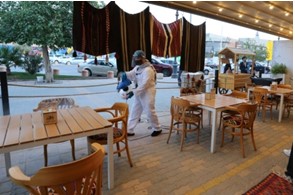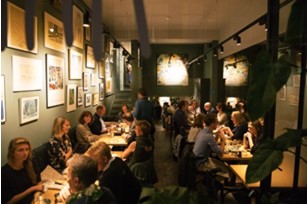Sanitization in Restaurant post Covid pandamic Reopening restaurants in India, world
Many restaurants in India have begun to put measures in place. From masks to disinfectants, a look at what is being done. Many of the measures recommended for restaurants to make a covid free restaurant like masks for staff and visitors (except when eating), sanitizers, reduced capacity are being followed by restaurants that have been reopening around the world.
Who's doing what : Masks, disinfectants, scans: Around the world, masks are mandatory for staff in most restaurants. Many have installed hand-sanitizing stations and thermal scans at entrances as well as tables, and some are posting daily temperatures of staff. Physical distancing : Restaurants have redesigned their spaces and reduced their capacities by 50 to 30 per cent. In India, the government has set a 50 per cent limit. Restaurants are reducing the number of tables and placing them farther apart. For reaching a highest level of disinfection in restaurants & making corona virus free restaurant McDonald's outlet in Arnhem, the Netherlands, is using automated wheeled carts to serve customers as a exception case because of very high cost. They even have added Mannequins, dolls & Robots to reduce human staff . How to create minimum surface contact: For disinfection in restaurants not only cleaning can help but also worldwide restaurants are trying to reduce the number of surface objects that customers and staff will come in contact with. Ex.- use of disposable menus, Menus from restaurant app & do away with physical menus altogether, and are offering scannable codes, with disposable bottles etc.... No more buffets: Many restaurants are reopening without buffet brunches and other communal meals. In India, the government has advised physical distancing during buffets. These are some of the measures which will create disciple in making corona virus free restaurant and also ensuring parallel way of sanitization in restaurant. Other important steps adopted or likely to be adopted most of restaurants in India as follows.
- Managing Employee Health (Including Contracted Workers)
- Guidelines for Staff for Maintaining Personal Hygiene
- Managing Operations in a Foodservice Establishment or Retail Food Store
- Regular Inspection of Kitchen Areas, Dining Areas, and Restrooms
- Regular Sanitization of Restaurant Kitchen Equipment
- Develop a Restaurant Hygiene Checklist
- Ensure Proper Ventilation
Special attention is given to disinfectants and sanitizers for use on food contact surfaces
There are numerous commercial products available for disinfecting and sanitizing surfaces in food premises, such as restaurants or processing plants.
Requirement of disinfectant : Ease of application - Low toxicity - Non-corrosive - Good penetrative power - Fast acting - No harmful or offensive odour - Stability (long shelf life for concentrate) - Compatibility with other chemicals and material of construction Broad spectrum of activity to deactivate bacteria, fungi, and viruses
Still how Clean Are Restaurant ?
Evidence Gap: Covid free restaurant is a every day task . Although proper cleaning before sanitizing should reduce any risk of producing disinfection by-products, there is little information on whether the production of disinfection byproducts is a problem in real-world situations, where surfaces may not always be cleaned properly.
Part of the challenge in defining appropriate cleaning is that cleaning of Restaurant presents some unique management issues.
1.Time limitation - In addition to staffing challenges such as the limited amount of time available for Restaurant cleaning, the surfaces to be cleaned are different than in other industries. 2. Damages to equipment and "expensive interior" due to harsh chemicals for disinfection - damaged by liquids, or susceptible to discoloration or bleaching from certain detergents or sanitizers. At the same time, little academic research has been done to help managers in the restaurant industry with these challenges. If management knew the areas presenting the highest risk of contamination, cleaning protocols could be targeted for these areas. 3. Lack of microbiology knowledge at operating staff (eg.) - * POOR PERSONAL HYGIENE - Food handlers are carriers of disease causing bacteria. Food service personnel can contaminate food. * Cross Contamination - occurs when microorganisms are transferred from one surface or food to another. * Viruses are the simplest and tiniest of microbes; they can be as much as 10,000 times smaller than bacteria. Viruses comes in many sizes and shapes viruses consist of a small collection of genetic material (DNA or RNA) encased in a protective protein coat called a capsid. Some may survive in freezing and cooking. 4. Why Microbiological assessment is necessary - Restaurant cleanliness is based on observation and not on microbial assessment even though recent reports suggest that infections may be acquired while staying in Restaurants. Data suggested the presence of microbial contamination that was not reflective of visual assessments. Unfortunately, no standards exist for interpreting microbiological data and other indicators of cleanliness in Restaurants. 5. In summary, many industries no longer consider visual assessment adequate for assessment of cleaning and other more objective standards are being researched. Although the correlation between microbial contamination and infection rates would appear to provide the strongest evidence for where to set the objective standards for cleaning levels, research results on the relationship is mixed. The concept of looking at microbial levels after "best practices" or "rigorous" cleaning, however, may be useful. 6. General microbial contamination has been quantified through aerobic plate counts (APC). Results are reported as CFU/ cm2. These tests give specific information relative to bacterial contamination, but are more expensive and time consuming than ATP tests. 7. Conclusion - microbiological testing is used as a restaurant cleaning bench-mark, almost all tested surfaces (Dining Table, Chairs, Menu card, show pieces, salt & paper bottles, sauce bottles etc.., Door handles, Bathroom sink and faucet) Almost all "High Contact Surface " in a restaurant will likely to fail or show surprising results with "Sanitized with new chemicals & new procedures post covid" when microbiological standards set in like other industries were used for the Restaurants. In Restaurant and Hotels UV light is more popular worldwide and it can deactivate coronavirus and other pathogens to 99.9% (germs free restaurant wherever UV irradiation is possible) Autocoat Engineering is the most experienced in manufacturing innovative products since last 35 years in India and now with need of the hour we bring you a product you can trust & use to be safe .
Click Here for information on UV radiations & our UV products





